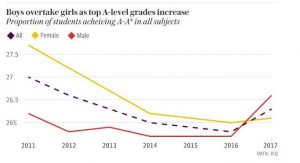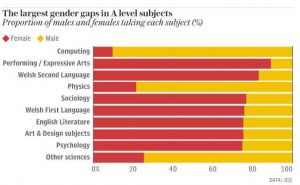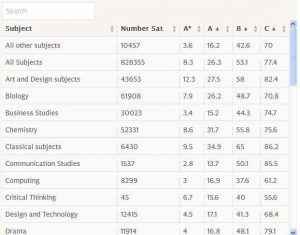Insights into the 2017 A Level exams results – Debunking the equality illusion created by liberal gender politics
The following images tell the true story about the A Level exams and what has been going on with the UK’s school education system that reaches right up into its universities, many of which used to be polytechnics until their status was changed.
What are the very well advertised improvements to the UK’s examination system since 2010 worth in real terms? – No doubt not very much. Education is still dominated by the mindless drive to create a non-achievable social equality.
Read the following blog post by Peter Hitchens to put yourself in the know about the history of English school examinations. The article begins with: “Here’s what they will never say about British school examinations.” Hitchens’ column in the Mail on Sunday was about cyclists, so maybe he was refused permission to republish his article on British school examinations so soon after the results came out. The comments are very well worth reading. Note that Scotland has its own school and examination system.
“From O Level to No Level” Republished after five years. What really happened to English examinations –
http://hitchensblog.mailonsunday.co.uk/2017/08/…
The drive for higher educational standards started in 2010
When the Tories came into coalition government with the LibDems in 2010, Michael Gove began tightening up the dumbed-down, feminised standards of the school examinations – GCSEs taken at the age of 16 and A Levels taken at the age of 18.
Strangely enough, each year from 2011, the results of the A Level exams for girls began to fall and
were still falling in 2016, increasing slightly in 2017.
As the image below shows, the boys’ results didn’t change significantly until course work was removed from the results in 2016, after which they increased markedly enough to take them ahead of the girls’ results. The marked increase in the boys’ results has driven the All results up higher than the girls’ results.

Course work should never have been included in the exam results
Course work should never have been included in the exam results, because it is an easy way of cheating. No one knows who did the course work. Therefore, it is far easier than using any other form of cheating, including getting someone else to sit your exams.
Boys tend to take the much more difficult science and information-technology subjects
Boys tend to take the much more difficult science and information-technology subjects while the girls tend to take the soft subjects – arts, languages, design, etc. Therefore, the results will always have an innate tendency to look better for girls. That they are no longer doing so, shows that the girls’ results are falling far more in real terms than the figures suggest. For example, the standards of the English Literature exams have been tightened, so the take up has fallen in favour of the subjects that have yet to be tightened up (e.g., Sociology, Psychology, Geography, etc).
Here is the breakdown of the subject categories taken by boys and girls.

A* grade was only introduced in 2010
It is interesting to know that the A* grade was only introduced in 2010 by Michael Gove in order to be able to distinguish the students with the best academic ability. Before it came in, around 25% of students were getting A grades, ridiculously covering the best students and the upper range of average students – the more so the softer the subjects.
The percentage difference between an A* and an A grade is far too high
The fact that around 25% of students are getting A* or A grades should not be the case if the identification of academic excellence is the desired result. The difference between an A* and an A grade is far too high. Around 5% for an A* grade compared to around 20% for an A grade. The A* is the grade that distinguishes the best students from the rest. Moreover, A* grades in the soft subjects that girls tend to take are easier to achieve than the A* grades in the more difficult subjects that boys tend to take. The reason for this being the case is no doubt the current drive to get as many students as possible into university. In short, the aim is quantity over quality. Ideology over reason.
The drop-down menu below, shows the percentages A* to C grades achieved in 2017 for each subject.
You can read the full article from which these images were taken and access the drop-down menu, shown below, here:

Conclusion
The education sex war is phony. It is the creation of the liberal falsifiers who dumbed-down and feminised the entire education system in order to prove the validity of their equality agendas. How much damage they have done to the UK’s economy and family structure doesn’t bear thinking about.
Damage that can be measured by the growing number of single parents, the decrease in marriages, divorces and the extent to which the UK depends on immigrants to get its work done to high enough standards, due to the poor standard of school leavers and graduates. No doubt an intended side-effect is that the EU immigrants favour being in the EU, with the third-world immigrants tending to have liberal left-wing views.
This country has to have the best education system it can provide
This country has to have the best education system it can provide because it has few natural resources and therefore depends on its population. It cannot afford to be dogged by gender politics. As you may have noticed, the media, the BBC in particular, has NOT been using exam results to beat the drum for females since 2011, poor dears. Is this state of affairs responsible for the marked increase in the amount of feminist propaganda the BBC is putting out. The most prominent example of which was giving Dr Who a sex change. Right now, it is difficult to channel-hop on the BBC without coming across a woman depicted being the boss and chewing the ear off some man or men.
The article linked to above is on the website of The Telegraph, one of the few media outlets to have produced something on the A Level results. The BBC and Sky News were in and out as quickly as possible, while the Daily Mail gave the topic a complete miss.
However, the almost worthless GCSE exams, taken at the age of 16, have been given the kind of treatment that the higher A Level exams should be getting. Here is an article on the GCSE pass rates for Mathematics, which at GCSE level involves mostly multiple-choice questions on arithmetic, not mathematics.
GCSE exam you only need 18 per cent to pass: Fears that grades are being ‘given away’ in maths test –
http://www.dailymail.co.uk/news/article-4821434/GCSE-exam-need-18-cent-pass.html
Inferior GCSE exams replaced the superior O Level exams in 1986
The academically much lower GCSE exams replaced the much higher O Level exams in 1986. For example, the exam for O Level Mathematics did not use multiple choice questions that give a student a 1 in 4 chance of guessing the right answer. The student had to work out each question on paper and was marked on how much of the workings were correct. O Level Mathematics required a working knowledge of quadratic equations, trigonometry, geometry and even calculus. If students of GCSE Mathematics tried to sit the O Level Mathematics exam, they wouldn’t know whether they we coming or going. Indeed, they would all fail unless they had educated themselves to a relatively high level on real mathematics.